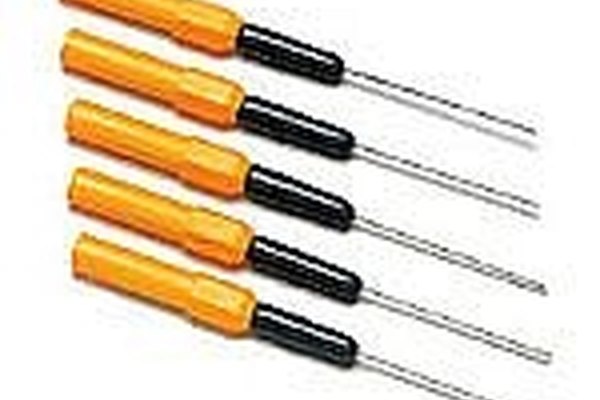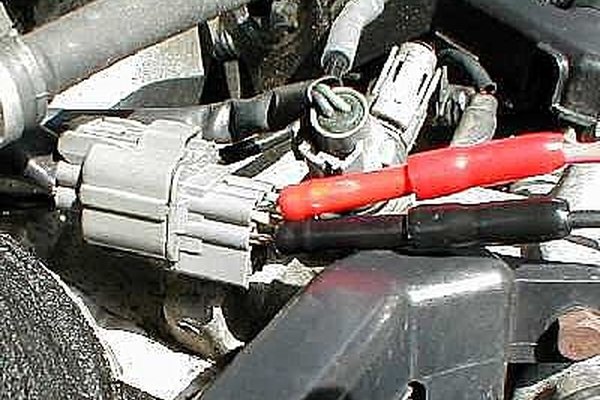How to Test an O2 Sensor (with Video)
by Corinne BaumUpdated July 12, 2023
On a gasoline engine, an oxygen sensor is used to ensure that the proper air fuel ratio is reaching the engine. It compares the amount of oxygen in the air to that in the exhaust pipe.
Some automotive manufacturers recommend that oxygen sensors should be replaced once every 100,000 miles whether they are working or not. However, this can be very expensive, especially since many newer cars and trucks have up to four different O2 sensors.
Usually, a check engine light will provide the first indication that you might have a bad oxygen sensor. Often, the engine code will simply state that there is a problem with the O2 Sensor, or it may diagnose your car an oxygen sensor heater circuit malfunction. This means that something is preventing your heater wires from working correctly, and it usually displays as a P0141 diagnostic trouble code (DTC) on your dashboard.
Since O2 sensors can be very expensive and the problem might not be with the oxygen sensor itself, it is a good idea to DIY troubleshooting and testing oxygen sensors before replacing them.
Oxygen sensors can be tested both on the vehicle and off, but many prefer to leave the oxygen sensor on the vehicle. However, by taking the oxygen sensor off, you are able to visually inspect the sensor, which can often provide a good indication that there is a problem, and testing the sensor is also a little easier.
Things You Will Need
- High-impedance Digital Voltmeter
- Backprobe
1. visually inspect the wires
Start by visually inspecting the wires leading to and from the O2 Sensor. Ensure that the wires are properly routed away from the exhaust components and that the wires are not damaged.
2. Start the car and let it run until the vehicle is warm
Next, start the car and let it run until the vehicle is warm, which usually takes about five minutes. The oxygen sensors have an operating temperature of 600 degrees Fahrenheit in order to provide an accurate reading. This will cause the engine to become very hot, so be careful. Usually, the oxygen sensor should read anywhere from 5 to 20 ohms.
3. Connect the backprobe

Connect the backprobe to the oxygen sensor's signal wire. Be very careful when using the backprobe, because the plastic connectors are often very brittle and can break easily.
4. Connect the positive lead

Connect the positive lead from the digital voltmeter to the backprobe.
5. Connect the ground wire
Connect the ground wire from the digital voltmeter to a good solid ground point on the chassis of the vehicle.
6. Turn the voltmeter on
Turn the voltmeter on and set it to the 1 volt scale. The voltage of the O2 Sensor will fluctuate between 100 and 1,000 millivolts, which is 0.1 and 1.0 volts, so having a quality voltmeter or digital multimeter is important.
7. Check the voltage reading
Turn the vehicle back on and check the voltage reading. The reading should fluctuate rapidly. If the sensor response stays at around 0.5 volts, ensure that the vehicle is fully warmed up. If the vehicle is warm and the O2 Sensor reading does not change, then there is a problem with the O2 Sensor and you can stop the test.
8. Create a vacuum leak to test sensor
Next, create a vacuum leak to ensure that the O2 sensor responds properly to a lean air-fuel mixture. Most vehicles have a vacuum port on the top of the engine, which can be opened up to create a vacuum leak.
Creating a vacuum leak should cause a multimeter or O2 sensor voltage to drop below .1 volts and then rise above .5 volts when the leak is subsequently plugged.
9. Perform a propane enrichment test if needed
If your vehicle does not have a vacuum port or if creating a vacuum leak causes the vehicle to stall, you can perform a propane enrichment test. This is done by adding some propane gas to the air intake, which should cause the voltage of the O2 Sensor to quickly rise.
10. Slightly close the choke as alternative test
As an alternative to a propane enrichment test, you can also slightly close the choke, which should cause the voltage of the O2 Sensor to quickly rise.
11. Determine if Oxygen Sensor needs replacement
If during steps 8 to 10 the voltage does not change or does not change in the expected manner, then the oxygen sensor is bad and should be replaced.
TIPS
If you don’t change the faulty oxygen sensor, you could have further problems down the road. Your fuel efficiency and gas mileage could go down because the car is in lean condition, which would lead to more fuel consumption and an overall worse fuel economy for your car. Additionally, your car’s engine performance could drastically degrade or you could fail an emissions test because of the amount of material coming from your exhaust system. If the problem persists, the damaged O2 sensor could seriously screw up your catalytic converter and spark plug.
Warning
The exhaust system and engine are very hot, so be careful to avoid burns. Make sure that neither the backprobe or the positive lead from the digital voltmeter make contact with the exhaust manifold or exhaust pipe.
Video: Troubleshooting Oxygen Sensor Problems
Helpful comments from the video:
- Not always will you get a check engine light, at least on this 94 geo metro. Mine was very, very, very, very bad. A very reliable mechanic told me that the O2 sensor will be completely bad before it will trip the engine light most of the time. When i replaced the O2 sensor, the problem went away.
- its free to hook it up at pepboys advanced, and O'railys
Tips
- Backprobes are used to check the voltage of a circuit from the back, so that the circuit is still complete.
- If you don't have a backprobe, you can use a small thin wire jumper instead, but be careful not to damage the plastic oxygen sensor connector.
- If you do not have a check engine light scan tool, most automotive stores can pull the code for you for free. However, they can usually only do this on cars that were made in 1996 or above.
- If you take the oxygen sensor out to visually inspect it, the sensor should be light tan in color. If it is red, white, black, or light gray the O2 Sensor is likely bad, but you should still test it.
Things You'll Need
- High-impedance Digital Voltmeter
- Backprobe
Warnings
- The exhaust system and engine are very hot, so be careful to avoid burns.
- Make sure that neither the backprobe or the positive lead from the digital voltmeter make contact with the exhaust manifold or exhaust pipe.






